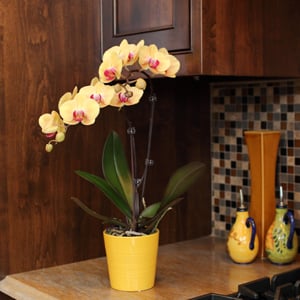 In our previous post, we discussed various points as to why the Phalaenopsis orchid is the perfect house plant. Today we continue in the conversation.
In our previous post, we discussed various points as to why the Phalaenopsis orchid is the perfect house plant. Today we continue in the conversation.
Below are more ways to consider bringing a Phalaenopsis orchid into your home!
- Phalaenopsis orchids must have good air circulation in order to grow well. They do not do well with cold or hot air blowing directly on them so take caution when choosing their placement.
- Phalaenopsis orchids require sunlight in order to grow, but direct sunlight will burn the plant and can eventually kill it. Indirect sunlight is best when considering placement of Phalaenopsis orchid plants.
- Phalaenopsis orchids are a tropical breed of plant so they require a bit of humidity to grow well. Don’t place them in a dry location or you will find that your orchid plant will become dry and listless.
- Phalaenopsis orchids go through a period of blooming and then a resting period. In our previous blog article about reblooming you will find more information about the Phalaenopsis orchid cycle of blooming. As a reminder, if an orchid is not blooming, it does not mean that the plant is dead. Orchids must go through a rest period where they gather their energy and gain strength for their next blooming cycle.
- As a general rule, the Phalaenopsis orchid survives quite well in the indoor temperatures that humans enjoy. When the plant is in active growth, temperatures from 75 to 85 degrees are best, but temperatures ranging from 65 to 70 degrees are suitable for the Phalaenopsis orchid.
Isn’t it time that you give a Phalaenopsis orchid a try? Check out our videos for invaluable information about growing Phalaenopsis orchids.


 In our previous post, we discussed various points as to why the Phalaenopsis orchid is the perfect house plant. Today we continue in the conversation.
In our previous post, we discussed various points as to why the Phalaenopsis orchid is the perfect house plant. Today we continue in the conversation.